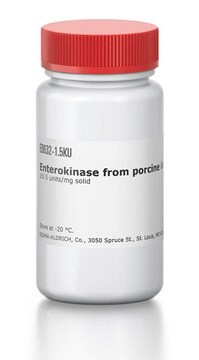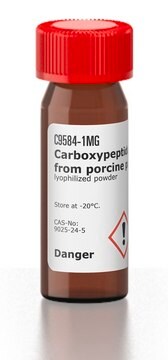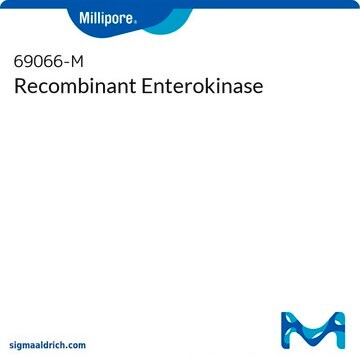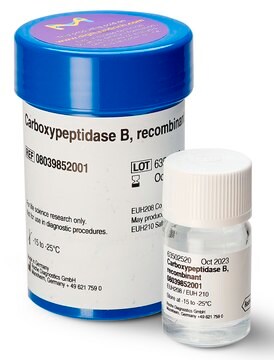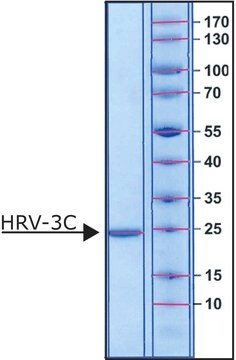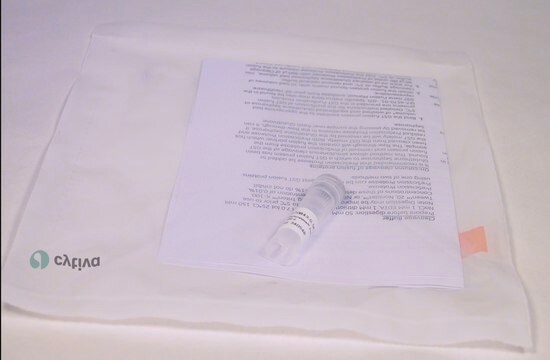Alle Fotos(1)
Wichtige Dokumente
E5144
Enterokinase from bovine intestine
powder
Synonym(e):
Enteropeptidase
Anmeldenzur Ansicht organisationsspezifischer und vertraglich vereinbarter Preise
Alle Fotos(1)
About This Item
Empfohlene Produkte
Biologische Quelle
bovine intestine
Qualitätsniveau
Form
powder
Mol-Gew.
150 kDa (consisting of 115kDa and 35kDa subunits.)
Farbe
white
Versandbedingung
dry ice
Lagertemp.
−20°C
Suchen Sie nach ähnlichen Produkten? Aufrufen Leitfaden zum Produktvergleich
Allgemeine Beschreibung
Enterokinase also referred to as enteropeptidase, is a transmembrane protein. This intestinal protease contains a heavy chain and a light chain linked by a disulfide bond. The amino-terminal sequence of the bovine enteropeptidase is homologous to trypsin-like serine proteases. Enterokinase is a highly specific serine protease that is used for the removal of the FLAG peptide from N-terminal and Met-N-terminal fusion proteins. It does not remove the C-terminal FLAG.
Anwendung
Enterokinase from bovine intestine has been used to remove S-Tag and N-terminal His-tag from recombinant glutathione peroxidase 1 (Gpx1). It has also been used to cleave interleukin-2 (IL-2) protein from the granules
Enterokinase is a member of the S1 peptidase family. In vivo, it is responsble for the proteolytic activation of trypsin from trypsinogen. Enterokinase is used for site specific cleavage of recombinant fusion proteins containing an accessible enterokinase recognition site for removal of affinity tags.
Biochem./physiol. Wirkung
Enterokinase catalyzes the proteolytic activation of pancreatic proteases. This action prevents the harmful tissue damage produced by the autoactivation of pancreatic proteases in the pancreas. Enterokinase recognizes Lys or Arg residues in the peptide. Lack of enterokinase can harm food digestion and absorption mechanism. Enterokinase is a highly specific serine protease that is used for the removal of the FLAG peptide from N-terminal and Met-N-terminal fusion proteins. It does not remove the C-terminal FLAG.
Verpackung
Supplied with optimized enterokinase buffer
Einheitendefinition
One unit is that amount of enterokinase which results in >95% cleavage of 1 µg of purified FLAG-BAP fusion protein in 18 hours at 37 °C. One FLAG-BAP unit is equal to 10x the activity of a standard trypsinogen unit.
Sonstige Hinweise
Do not used PVDF since free FLAG peptide will bind to the PVDF membrane.
Substrat
Produkt-Nr.
Beschreibung
Preisangaben
Lagerklassenschlüssel
11 - Combustible Solids
WGK
WGK 3
Flammpunkt (°F)
Not applicable
Flammpunkt (°C)
Not applicable
Persönliche Schutzausrüstung
Eyeshields, Gloves, type N95 (US)
Hier finden Sie alle aktuellen Versionen:
Besitzen Sie dieses Produkt bereits?
In der Dokumentenbibliothek finden Sie die Dokumentation zu den Produkten, die Sie kürzlich erworben haben.
Kunden haben sich ebenfalls angesehen
B Thomas Bäckström et al.
BMC biotechnology, 7, 3-3 (2007-01-06)
Fluorescence activated cell sorting (FACS) is a powerful technique for the qualitative and quantitative detection of biomolecules used widely in both basic research and clinical diagnostic applications. Beads displaying a specific antigen are used to bind antibodies which are then
Claude Castella et al.
Nitric oxide : biology and chemistry, 68, 125-136 (2017-02-15)
Plant glutathione peroxidases (Gpx) catalyse the reduction of various peroxides, such as hydrogen peroxide (H
Sang Youn Hwang et al.
Colloids and surfaces. B, Biointerfaces, 94, 296-303 (2012-03-09)
Encapsulation of active proteins in the hydrophilic core of vesicular liposomes is important for developing a therapeutic protein carrier system. The efficiency of liposomal encapsulation of proteins is generally low. A better understanding of the fundamental mechanisms of encapsulation is
Katrin Grage et al.
Applied and environmental microbiology, 77(18), 6706-6709 (2011-08-02)
A novel approach to produce purified recombinant proteins was established. The target protein is produced as polyhydroxyalkanoate (PHA) synthase fusion protein, which mediates intracellular formation of PHA inclusions displaying the target protein. After isolation of the PHA inclusions, the pure
Fengyun Li et al.
Analytica chimica acta, 724, 104-110 (2012-04-10)
Bioluminescence resonance energy transfer (BRET) has gained favors in recent years as a detection technology for protease activity due to its extreme reliability, high sensitivity and low intrinsic backgrounds. Because of the sensitivity of the donors, substrates and the acceptors
Unser Team von Wissenschaftlern verfügt über Erfahrung in allen Forschungsbereichen einschließlich Life Science, Materialwissenschaften, chemischer Synthese, Chromatographie, Analytik und vielen mehr..
Setzen Sie sich mit dem technischen Dienst in Verbindung.
